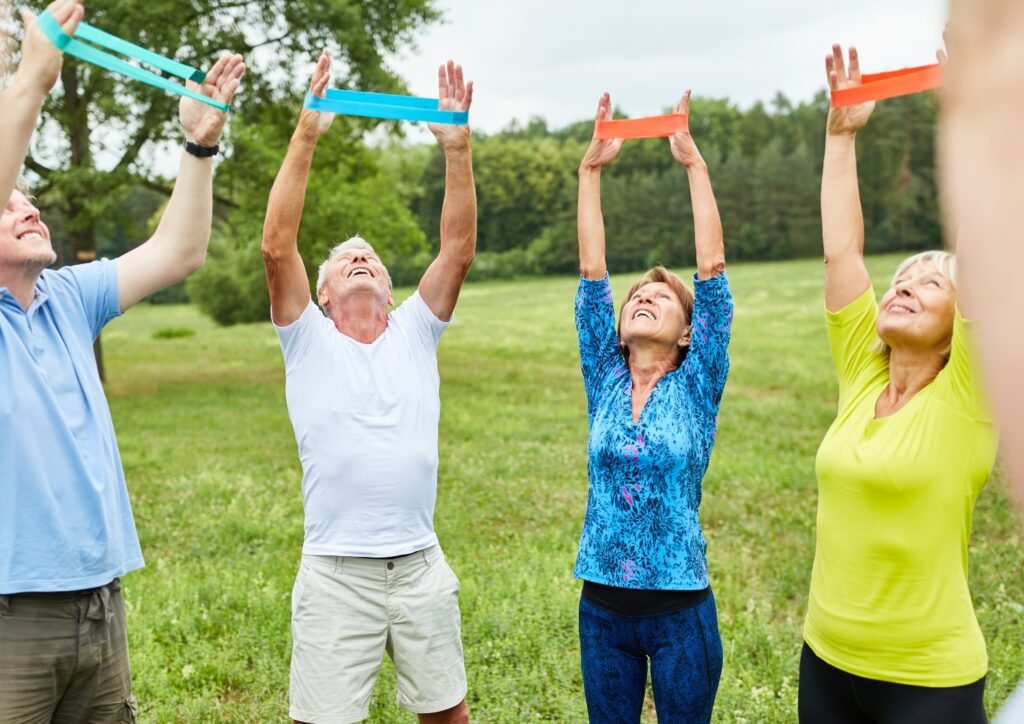Last Updated on June 27, 2025 by Julian Espinosa
Feeling stiff when you get out of bed? You’re not alone. As we age, our muscles and joints naturally lose some of their youthful flexibility—but that doesn’t mean we have to accept limitation as our new normal. Regular stretching offers a simple yet powerful way to maintain and even improve your mobility, regardless of your current fitness level.
Beyond the physical benefits of increased flexibility and reduced muscle tension, stretching delivers remarkable mental health advantages too, boosting mood, enhancing cognitive clarity, and reducing stress through the release of feel-good endorphins.
In this comprehensive guide, we’ll explore why stretching is particularly valuable for seniors, how it works on a physiological level, and provide practical, safe stretching exercises you can incorporate into your daily routine.
Whether you’re dealing with arthritis discomfort, recovering from injury, or simply want to maintain an active lifestyle, these gentle stretching techniques can help you move with greater ease and live with more comfort. Ready to discover how just a few minutes of daily stretching can transform how you feel both physically and mentally?
How Stretching Improves Your Overall Fitness
Do your limbs and muscles often feel tight and stiff when you wake up? Have you noticed more frequent aches and pains despite getting sufficient sleep? There’s a scientific reason behind these sensations. As we journey through life, we naturally begin to lose fluid and flexibility in our joints and muscles.
The aging process, combined with factors like arthritis, prolonged periods at a desk or computer, and the repetitive motions of everyday activities like housekeeping or gardening, can significantly reduce our natural flexibility.
Beyond causing discomfort in your neck and body, this decreased flexibility can make routine activities surprisingly challenging—like picking up something from the floor or simply turning your head to check for traffic while driving.
Prefer to listen rather than read?
We all have unique relationships with physical activity. Some embrace it enthusiastically, while others might be hesitant to engage in even light exertion. There are also those who appreciate the unintentional benefits of exercise that come from everyday activities they enjoy.
For example, walking your dog provides the cardiovascular benefits of a brisk walk. Gardening offers the physical advantages of bending, stretching, and light resistance work. The key is finding activities you genuinely enjoy that keep you moving naturally.
Whether you’re exercise-enthusiastic or exercise-averse, stretching offers universal benefits that healthcare professionals widely endorse. Licensed physicians consistently affirm that stretching is beneficial for your overall wellbeing—an assertion most healthcare providers would readily support.
True, stretching doesn’t deliver the same cardiovascular benefits as more vigorous activities like mountain biking or swimming. However, even a few minutes of stretching is significantly better than remaining completely sedentary.
As David Behm, an exercise scientist at Memorial University of Newfoundland’s School of Human Kinetics and Recreation, notes in his research: “Stretching is such a basic part of keeping the living body agile that even animals practice it regularly.”

Understanding the Science: The Thixotropic Effect
How exactly does stretching work to improve your physical well-being? When you stretch, something fascinating happens within your body called the “thixotropic effect.” This scientific term describes how your body temperature rises and pressure increases within your soft tissues.
Think about what happens when you stir a bottle of honey that’s become thick and difficult to pour. As you stir, the honey becomes more fluid and pours more easily. Your muscles and tendons respond similarly to stretching—they become less viscous and move with greater fluidity.
This is why getting up from your desk for a quick stretch every hour is actually more beneficial than sitting still. Even mindless movements like shifting in your chair can increase blood flow. For the nervous system, these small movements send signals that promote relaxation and reduce tension.
Is Stretching Really That Important?
Including stretching in your morning routine can provide significant relief from muscle tension and offer numerous benefits beyond just physical flexibility.
Muscle tension is a common ailment that many individuals endure in today’s fast-paced and often sedentary lifestyle. Whether it’s due to prolonged periods of sitting, oversleeping, strenuous physical activity, or stress, the discomfort associated with muscle tension can significantly impact one’s quality of life.
Fortunately, incorporating a simple stretching regimen into your morning routine can be a powerful tool in alleviating muscle tension. The science behind stretching is fascinating—when a muscle is stretched, the muscle spindle (a sensory receptor within the muscle) is activated. This activation triggers a reflex that leads to muscle relaxation, effectively reducing tension.
Stretching also increases blood flow to the targeted muscles, enhancing the delivery of oxygen and essential nutrients while facilitating the removal of waste products. This improved circulation acts as a natural antidote to the stiffness and discomfort often associated with muscle tension.

A Regular Stretch Routine Can Boost Your Energy
Regular stretching also promotes flexibility and suppleness in muscles and joints. Improved flexibility facilitates more efficient movement, reducing the effort expended in daily activities and, consequently, conserving energy.
Regular stretching enhances blood circulation throughout the body. The elongation of muscles during stretching stimulates blood flow, ensuring vital organs receive an adequate supply of oxygen and nutrients. This increased circulation provides a sustained source of energy for bodily functions and physical activity.
Joint mobility, which often becomes compromised with age, is another aspect positively influenced by stretching. Maintaining and enhancing joint flexibility through stretching enables older adults to move with greater ease and less discomfort, resulting in a conservation of energy that might otherwise be spent overcoming physical limitations.
Beyond its physiological benefits, stretching significantly impacts mental and emotional well-being. Engaging in regular stretching fosters a sense of mindfulness and relaxation. This meditative aspect helps alleviate stress and tension, known culprits for draining energy.
Moreover, stretching stimulates the release of endorphins, the body’s natural mood-enhancing chemicals. The resulting sense of well-being and positivity contributes to a more energized state, both physically and mentally.

Stretching Promotes Mental Clarity
Stretching exercises directly influence the physiological processes underlying mental clarity. As muscles are elongated during stretching, blood flow to the brain is enhanced. This increased circulation ensures a steady supply of oxygen and nutrients essential for optimal cognitive function.
The increased circulation from stretching also helps deliver oxygen and nutrients to brain cells, fostering optimal cognitive function. As neurochemicals like dopamine and serotonin are released during stretching, they play crucial roles in mood regulation and cognitive performance, helping to create a foundation for improved mental clarity.
The mind-body connection established during stretching encourages individuals to be attuned to their physical sensations and movements. This mindfulness extends to cognitive processes, promoting a clear and focused mental state.
Stretching also induces a state of relaxation by encouraging conscious, controlled breathing patterns. The act of extending your limbs prompts a mindful awareness of the body, anchoring individuals in the present moment and diminishing mental clutter associated with stress and anxiety.
The integration of breath with your stretches further strengthens the mind-body connection. Conscious and controlled breathing patterns during stretching exercises have a calming effect on the nervous system, reducing mental chatter and promoting clarity of thought.

Stretching Improves Your Posture
While stretching might not immediately come to mind when thinking about posture improvement, it plays a significant role in maintaining proper body alignment.
In some cases, people are born with genetic conditions that affect the shape of the spine and hips, which can influence posture from birth. Such conditions can be managed with appropriate stretching to reduce their negative effects on posture over time.

Injuries from sports or other activities can also impact posture as the body naturally protects itself from further injury. For instance, if you’ve hurt your foot, you might unconsciously alter your walking pattern, which can affect your overall posture.
Our posture also changes due to the types of work we do and other daily activities that lead to using different parts of the body in varying ways. Underuse can also be problematic—weak back muscles on either side of the spine can affect our ability to maintain good posture, as can weak abdominal muscles.
For many people, sitting for long hours each day, year after year, causes muscles and ligaments to tighten or weaken, which can lead to poor posture.
Performing regular stretches is simple, time-efficient, and can be done practically anywhere—even while waiting in line at the grocery store.

It’s Good for Your Heart!
Recent research suggests that a consistent stretching regimen may enhance cardiovascular health. An Italian study involving 39 participants randomly assigned to three different groups demonstrated promising results.
The first group completed a 12-week program of five 40-minute stretching sessions weekly, focusing on bilateral leg, ankle, and foot exercises. The second group performed identical exercises but exclusively on the right side of the body, with sessions lasting 20 minutes. The control group abstained from any stretching activities.
Researchers used ultrasound and various techniques to measure blood flow, artery stiffness, and blood pressure before and after the stretching regimens. Both stretching groups exhibited improved vascular function throughout the body, even in arteries not directly targeted by the exercises.
Notably, blood flow increased significantly in the thigh, knee, and arm arteries, while blood pressure and arterial stiffness decreased. Conversely, the control group showed no observable changes.
Despite these positive outcomes, the improvements proved temporary. Within six weeks of concluding the program, vascular functions reverted to their original levels.
These findings, published in the Journal of Physiology, highlight that while stretching can benefit individuals who are injured or unable to engage in more vigorous physical activities, the effects on vascular health are not sustained over time.
Dr. Fabio Esposito, senior author and dean of the School of Exercise Science at the University of Milan, emphasizes the potential utility of stretching for those with limitations in participating in more demanding forms of physical exertion.

How to Incorporate Stretching into Your Morning Routine
Before you try stretching, make sure you do it safely and effectively. Consult your doctor and find out how you can incorporate a routine into your mornings. While stretching can be done at any time and virtually anywhere, using proper technique is crucial. Straining your body incorrectly can actually cause injury.
That said, establishing a structured and intentional morning stretch exercise routine is fundamental to unlocking the full spectrum of benefits. Begin with gentle full-body stretches, gradually engaging major muscle groups and joints. This ensures a gradual awakening of the body and minimizes the risk of injury.
As the routine progresses, incorporate more dynamic stretches, infusing controlled movements to elevate the heart rate and stimulate overall circulation.
Here are a few you might want to try:
- Neck Stretch
- Gently tilt the head from side to side, forward, and backward to release tension in the neck and upper shoulders.
- Shoulder Roll
- Perform slow, controlled circles with your shoulders, both forward and backward, to relieve tension and improve shoulder mobility.
- The Back Stretch
- While sitting on sturdy armchair, reach behind your left side and grab the backrest. Use your right hand to hold your left knee while twisting your upper body. Hold the stretch. Take a few deep, slow breaths. Repeat for the other side.
- Spinal Twist
- While seated or standing, twist the torso from side to side, reaching across the body, to enhance spinal flexibility.
- Chest Opener
- Interlace your fingers behind your back and open your chest, stretching the pectoral muscles.
- Forward Fold
- From a standing position, hinge at the hips and reach toward the toes, promoting flexibility in the hamstrings and lower back.
- Hip Flexor Stretch
- Step one foot forward into a lunge position, lowering the hips to stretch the hip flexors.
- Quad Stretch
- While standing, bring one foot toward your buttocks, holding the ankle to stretch the quadriceps.
- Calf Stretch
- Stand facing a wall, place one foot behind you, and press the heel into the floor to stretch the calf muscles.
- Ankle Circles
- Rotate the ankles in both directions to enhance ankle mobility and flexibility.
- Dynamic Arm Swings
- Swing the arms forward and backward to engage the shoulders and promote overall upper body flexibility.
Wrapping It Up
The key to overcoming morning stiffness and enhancing overall well-being lies in the simplicity and effectiveness of stretching. From improving flexibility and posture to promoting mental clarity and heart health, integrating a regular stretching routine into your daily life is important, especially as you age.
Remember, whether you’re dealing with the stiff aches and pains associated with a sedentary lifestyle or the natural challenges of aging, stretching helps to improve your quality of life. So, why wait? Start tomorrow morning with a few gentle stretches. Your body and mind will thank you for it.

Frequently Asked Questions
- What are the general benefits of stretching?
- Stretching helps improve flexibility, posture, and mental clarity. It increases blood circulation, which enhances nutrient and oxygen delivery to muscles and organs, including the brain. Regular stretching also reduces muscle tension, promotes better balance, and may even contribute to improved cardiovascular health when practiced consistently.
- How does stretching impact muscle tension?
- Stretching activates muscle spindles, causing muscles to relax and reducing tension. This increase in blood flow aids in delivering oxygen and nutrients while helping remove waste products, essential for muscle function and relief from stiffness. The thixotropic effect also makes muscles and tendons less viscous, improving their ability to move fluidly.
- Can stretching improve cardiovascular health?
- Yes, recent research indicates that regular stretching can temporarily improve vascular function. A 2023 study showed that participants who followed a consistent stretching program experienced increased blood flow, decreased arterial stiffness, and lower blood pressure. However, these benefits appear to require ongoing practice, as improvements reverted after six weeks without stretching.
- How does stretching contribute to mental well-being?
- Stretching promotes the release of endorphins, which are natural mood enhancers that reduce stress and anxiety while improving mental clarity and focus. The mindfulness aspect of stretching encourages being present in the moment, reducing mental clutter and promoting relaxation. Improved blood flow to the brain from stretching also enhances cognitive function.
- What are some recommended stretching exercises for a morning routine?
- Effective morning stretches include neck stretches, shoulder rolls, spinal twists, chest openers, forward folds, hip flexor stretches, quad stretches, calf stretches, ankle circles, and dynamic arm swings. Begin with gentle movements, gradually engaging major muscle groups, and always listen to your body to avoid strain.
- How long should I hold a stretch?
- For beginners, hold each stretch for 15-30 seconds. As you become more comfortable with your stretching routine, you can gradually increase to 60-second holds for deeper flexibility benefits. Always breathe deeply and relax into the stretch rather than forcing your body beyond its comfortable range.
- Can I stretch if I have arthritis or joint pain?
- Yes, but with caution and proper guidance. Gentle stretching can actually help manage arthritis symptoms by improving joint mobility and reducing stiffness. However, it’s essential to consult with your healthcare provider before beginning any new exercise regimen, especially if you have existing joint conditions. They can recommend specific modifications tailored to your needs.
- Is it better to stretch in the morning or evening?
- Both times offer unique benefits. Morning stretching helps reduce stiffness, increase blood flow, and prepare your body for the day’s activities. Evening stretching can help release the day’s accumulated tension and promote better sleep. The best time to stretch is when you’ll consistently do it—regularity is more important than timing.
REFERENCES
- Nakamura, M., Takeuchi, K., Fukaya, T., et al. (2023). Acute effects of static stretching on passive stiffness in older adults: A systematic review and meta-analysis. Archives of Gerontology and Geriatrics, 117, 105256.
- Warneke, K., Lohmann L.H., Plöschberger G., Konrad A. (2024). The effects of static and dynamic stretching on deep fascia stiffness: a randomized, controlled cross-over study. European Journal of Applied Physiology.
- Arntz, F., Markov, A., Behm, D.G. et al. (2023). Chronic Effects of Static Stretching Exercises on Muscle Strength and Power in Healthy Individuals Across the Lifespan: A Systematic Review with Multi-level Meta-analysis. Sports Medicine, 53, 723–745.
- Fortune Health. (2023). The Mental and Physical Benefits of Stretching: What This Essential Part of Your Workout Does for Your Brain and Body.
- Center for Healthy Aging. (2021). The simple act of stretching. Colorado State University.
- Fit After 55. (2024). Best Stretching Exercises For Seniors.
- Takeuchi, K., Nakamura, M., et al. (2023). Acute and Long-Term Effects of Static Stretching on Muscle-Tendon Unit Stiffness: A Systematic Review and Meta-Analysis. Journal of Sports Science and Medicine, 22(3), 465-475.
Disclaimer
The content provided on MySeniors.World is for informational purposes only and is not intended as either financial or medical advice. Always consult a qualified professional before making any investment or health-related decisions.
Posts may contain affiliate links, meaning we earn a commission – at no additional cost to you, if you click through and make a purchase. Your support helps us continue providing valuable content.


